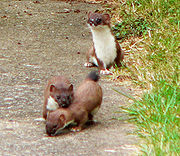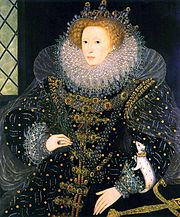
Stoat
Background to the schools Wikipedia
This Wikipedia selection is available offline from SOS Children for distribution in the developing world. SOS Children is the world's largest charity giving orphaned and abandoned children the chance of family life.
| stoat | |
|---|---|
 |
|
| Conservation status | |
|
Least Concern |
|
| Scientific classification | |
| Kingdom: | Animalia |
| Phylum: | Chordata |
| Class: | Mammalia |
| Order: | Carnivora |
| Family: | Mustelidae |
| Subfamily: | Mustelinae |
| Genus: | Mustela |
| Species: | M. erminea |
| Binomial name | |
| Mustela erminea Linnaeus, 1758 |
|
 |
|
| Range map | |
The ermine (Mustela erminea) is a small mammal of the family Mustelidae. It is also known as the short-tailed weasel and the stoat.
Natural history
The stoat can be found almost everywhere throughout the northern temperate, subarctic and Arctic regions, of Europe, Asia, Canada and the United States. It was introduced into New Zealand in an unsuccessful attempt to control the rabbit population and is considered a serious pest because it eats the eggs and young of native birds. It is also regarded as a major predator of adult female endemic birds that nest in cavities such as holes in trees. The stoat is considered to be the prime cause of the decline and/or extinction of a number of endemic New Zealand bird species. Stoats are largely nocturnal or crepuscular but will sometimes come out during the day.
Physical description
The stoat is a member of the family Mustelidae, which also includes other weasels, mink, otters, ferret, badgers, polecats, the wolverine, martens, the tayra, the fisher and in some taxonomical classifications skunks. This is one of the most species-rich families in order Carnivora. The stoat moves in a sinuous manner when pursuing its prey extremely quickly over the ground considering its small size and is also a strong swimmer that is able to colonize offshore islands. Although it inhabits northern latitudes the stoat is built long and thin, leading to an increased surface area-to-volume ratio and increased dissipation of heat from its body. The advantage of this shape is that it is one of the few species able to follow burrowing animals into their own homes. It partly compensates for this shape by having short legs, small ears, a fast metabolism and, in winter, thick fur. Stoats may grow up to 30 cm long, with males much larger than the females. In most areas it coexists with the Least Weasel (Mustela nivalis, also known as the European common weasel), and in this situation competition is reduced by the Least weasel, the smallest member of order Carnivora. Where the Least Weasel is absent the stoat is smaller (~70 g).

The stoat's coat is a rich medium brown with an off-white belly. In winter, the coat is thicker and in regions that experience an inch or more of snow for at least forty days of the year (such as in Armenia), the colour changes to clean white. This white fur is known as "ermine", a term originating either from the Latin phrase "Armenius mūs" ("Armenian rat") or from a word common to the Germanic and Baltic languages, hence the scientific name. At this stage the stoat itself may be referred to as ermine, or as being "in ermine". The winter stoat has been used in art as a symbol of purity or virginity. The white fur was highly prized, and used in the robes of the Lord Chief Justice of England. Both the animal and the heraldic tincture are symbols of Brittany. The furs would be sewn together making a pattern of black dots. A version of this pattern is used in heraldry as ermine tincture.
In all seasons the stoat has a black tip to its tail. The black tip probably serves as a decoy to predators, which would include almost any carnivore large enough to eat a stoat (e.g. wolves, foxes, wolverines, and some birds of prey). This kind of coat is very similar to the coat of the long-tailed weasel (Mustela frenata), a related animal of about the same size which also moults into white in the northern part of its range, and it is easy to confuse these kinds of weasels. The North American name for the stoat, the "Short-tailed weasel" arose because its tail length distinguishes it from the long-tailed weasel. In general it is found farther north. Both species can be distinguished from the Least Weasel because the Least weasel always lacks a black tip on its tail.
Diet
The stoat is a carnivore. It eats insects, rabbits; rodents such as the mouse, vole and rat; other small mammals; birds and their eggs and young; and sometimes fish, reptiles, amphibians, and invertebrates. It is a very skillful tree climber and can descend a trunk headfirst, like a squirrel. The stoat is capable of killing animals much larger than itself. When it is able to obtain more meat than it can eat it will engage in "surplus killing" and often stores the extra food for later. When this is the case, it will often kill by breaking the prey's neck without marking the body, presumably so its cache does not spoil easily. Like other mustelids it typically dispatches its prey by biting into the base of the skull to get at the centers of the brain responsible for such important biological functions as breathing. Sometimes it will also make preliminary bites to other areas of the body. In most areas in which stoats and least weasels co-exist, the Least weasel generally takes smaller prey and the stoat slightly larger prey. The larger male stoats generally take larger prey than females. Commonly, the stoat falls prey to animals such as the wolf, fox, cat or badger.
Reproduction
The stoat is territorial and intolerant of others in its range, especially others of the same sex. Within its range, it typically uses several dens, often taken from prey species. It usually travels alone, except when it is mating or is a mother with older offspring. It breeds once a year, producing several young kits (or kittens) per litter, and its mating system is promiscuous. Copulation occurs during the mating season with multiple partners and is often forced by the male, who does not help raise the offspring. Sometimes it occurs when the female is so young she has not even left the den. In spite of being such a small animal, the stoat's gestation is among the longest reported for mammals (11 months) because of the adaptation of delayed implantation, or embryonic diapause, in which a fertilized egg is not implanted in the uterus until months later. The animal's "real" gestation is much shorter. This is presumably an adaptation to the highly seasonal environment in which the stoat lives.
Senses and behaviour
Communication (and also location of prey) occurs largely by scent, since the stoat as typical of mammals has a sensitive olfactory system. As a result much of this communication is missed by human observers. However, stoats are believed to identify females in estrus by scent, and also the sex, health and age of prey. Some kinds of rodents such as voles have counter-adapted by being able to shut down reproduction (which makes females slower and easier to catch) if they smell the odour of mustelids. The stoat's visual resolution is lower than that of humans and colour vision is poor, although night vision is superior. Like most other non-primate mammals they have dichromatic colour vision (they can distinguish long from short wavelengths of light, but cannot make distinctions of hue within those bands). Tactile information is conferred by the vibrissae, or whiskers. When alarmed, a stoat can release a powerful musky smell from glands near its anus.
Subspecies
- Mustela erminea
- Yellow-necked ermine Mustela erminea ? Range: Northern Shaanxi, China
- Mustela erminea alascensis
- Mustela erminea algiricus
- Mustela erminea anguinae
- Mustela erminea angustidens
- Mustela erminea Arctica
- Mustela erminea audax
- Mustela erminea bangsi
- Mustela erminea celenda
- Mustela erminea fallenda
- Mustela erminea ferghanae
- Mustela erminea gulosa
- Ermine haidarum Mustela erminea haidarum Range: Queen Charlotte Islands, Canada
- Mustela erminea herminea
- Mustela erminea hibernica (Thomas and Barrett-Hamilton)
- Mustela erminea imperii
- Mustela erminea initis
- Mustela erminea invicta
- Mustela erminea kadiacensis
- Mustela erminea kanei
- Mustela erminea labiata
- Mustela erminea leptus
- Mustela erminea lymani
- Mustela erminea microtis
- Mustela erminea mortigena
- Ermine weasel Mustela erminea muricus
- Hondo stoat Mustela erminea nippon Range: Central and northern Honshū, Hondo StoatJapan
- Olympic ermine Mustela erminea olympica Range: Olympic Peninsula, Washington
- Ezo Stoat Mustela erminea orientalis Range: Hokkaidō, Japan; Japanese: ezo-itachi " Ezo weasel", okojo "stoat/weasel", shiro-ten "white marten"
- Mustela erminea polaris
- Mustela erminea pusilla
- Mustela erminea richardsonii
- Mustela erminea rixosa
- Mustela erminea salva
- Mustela erminea seclusa
- Mustela erminea semplei
- Mustela erminea streatori
- Mustela erminea vulgaris
- Mustela erminea whiteheadi
Stoats and humans
The skins were prized by the fur trade, especially in winter coat, and used to trim coats and stoles. The fur from the winter coat is referred to as "ermine". In Europe these furs were a symbol of royalty; the ceremonial robes of members of the UK House of Lords are trimmed with ermine, though artificial fur is now used. The ermine was also considered a symbol of purity in Europe. In some Nordic countries the stoat is invoked as a symbol of curiosity and timely action. In some areas of Japan, because of its adorable appearance and somewhat elusive nature it is still considered a symbol of good luck. While unusual, stoats have been known to attack sleeping humans.


